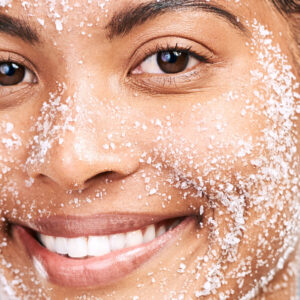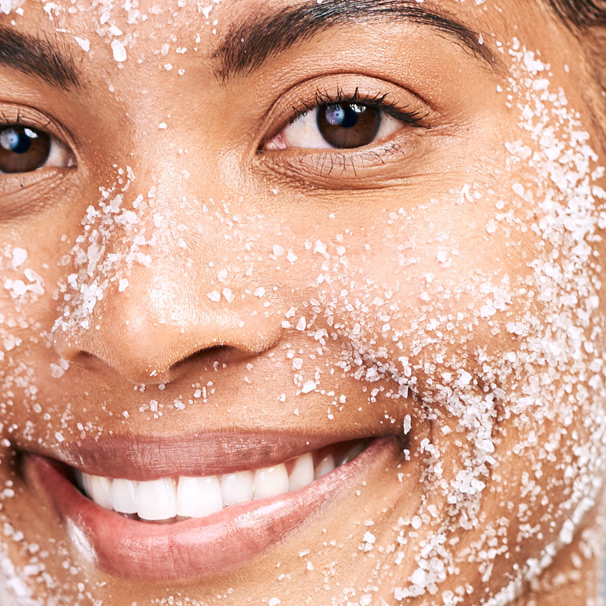Exfoliation
It's widely known that exfoliation is good for your skin, and most beauty junkies choose to exfoliate regularly. But is the rationale for partaking in this daily grooming habit apparent, or is it simply performed because beauty editors universally demand it of us?
Breaking The Ties That Bind
The perception that exfoliation is healthy has true roots in the structure and physiology of the skin. While skin thickness varies by region, the epidermis is on average composed of 30 layers of cells, (16 in the outermost stratum corneum), stacked upon each other like bricks. And like a brick wall, an intercellular cement runs between the cells, in effect acting like glue. Between the cells are microscopic fibers, (tonofilaments), which anchor the cells together.
Daily epidermal cells are invisibly shed through the body's natural means of exfoliation. So invisible is the process that in fact, every 28 days the epidermis is completely replaced without notice.
Why Exfoliate?
There are a number of reasons to exfoliate, all of them ultimately have the same goal achieve a healthier appearing complexion.
- Dry Skin
Dry skin simply builds up and distracting flaking is the end result. Cold, dry weather is frequently the cause. Overuse of drying perfume-filled non pH-balanced cleansers is another. Humidify your environment, use a gentle soap-free cleanser and moisturizer frequently; ideally with a product that contains a chemical exfoliant. Body scrubs can be beneficial when used a few times per week. This helps speed up the elimination of excess noticeable dry skin and allows your moisturizer to penetrate more easily. The result; skin so fresh you feel like you could go without stockings if the weather wasn't so cold. - Acne/Pore Size
Poor exfoliation practices and plugging beneath the skin's surface can lead to acne, blackheads and even large-looking pores. Use a cleanser such as DERMAdoctor Ain't Misbehavin' medicated aha/bha acne cleanser and apply DERMAdoctor Picture Porefect pore minimizer. - Aging Skin
As we age, not only do our epidermal cells get larger, the overall thickness of the epidermis increases. And natural oil production wanes. Blotchy skin discoloration, the by product of years spent out in the sun also affects the complexion. The result; dull, drab, aging looking skin. Use DERMAdoctor Physical Chemistry facial microdermabrasion + multiacid chemical peel once or twice a week to help speed up the elimination of these undesirable symptoms. For discoloration, DERMAdoctor Photodynamic Therapy age spot eraser & skin brightener is an ideal option. And don't forget your sunscreen. - Dermatologic Concerns
Sometimes dermatologic disorders such as psoriasis can wreak havoc with the appearance of your skin. A thickened epidermis and increased rate of cellular production leads to thick red plaques and white flaking scale. Here physical exfoliation is out; it can actually worsen the condition. Soften plaques with treatments that contains chemical exfoliants and let your dermatologist prescribe the treatment that will hasten resolution of this concern.Corns and callouses can result from continuous friction. Besides trying to do the obvious, (offset the skin from persistent rubbing with some form of pad), physical exfoliation can quickly help cut through the debris. Specially designed foot files and rasps can help remove the build up. Then you can turn to softening agents such as DERMAdoctor KP Duty dermatologist formulated AHA moisturizing therapy for dry skin to keep those annoying bumps at bay.
How Does One Exfoliate?
The most well known form of exfoliation is termed physical exfoliation. It involves mechanically removing superficial layers of the skin. The stereotypical example is an adolescent peering into the bathroom mirror, scrubbing over-enthusiastically with a buff puff, loofa or washrag. Often this also involves a cleanser containing ground up pits, seeds, sugar or salt crystals, or any other form of potentially abrasive particle that can possibly be found. For physical exfoliation with non-irritating scrubbing particles try DERMAdoctor KP Duty dermatologist body scrub with chemical + physical exfoliation.
Physical exfoliation reached a new technological high when microdermabrasion was introduced into medical offices several years ago. Basically a form of sandblasting the skin, these machines contain either aluminum or salt crystals that hit the skin at high speeds and are simultaneously vacuumed away along with the cellular debris that they remove.
The biggest problem with physical exfoliation has been the nature of the natural particles. Whether found in cleansers or the microdermabrasion products themselves, natural particles are very like snow flakes. No two are the same and all possess jagged edges capable of causing microscopic abrasions to the skin. Synthetic particles are much kinder to the skin, being completely round and much less likely to traumatize delicate tissues. Their popularity has hit a zenith with the introduction of beads capable of self-destructing with persistent rubbing. This helps reduce the potential of trauma that can be caused by die-hard exfoliating enthusiasts.
Chemical exfoliation consists of applying topicals (usually a form of alpha hydroxy acids and/or beta hydroxy acid), that in essence dissolve the glue around the cells, hastening the shedding of several layers of the epidermis. The more potent the chemical concentration, the potentially deeper the penetration. Naturally, caustic agents can cause skin discoloration and scarring, so only mild to the mild side of medium peeling agents can be used safely at home.
Chemical exfoliation can be achieved by one of two common ways. Either a product containing alpha and/or beta hydroxy acids can be applied to the skin which remains there for the day, (such as a rejuvenator or moisturizer), or higher potency chemicals can be applied for but a few minutes in the form of a chemical peel.
While dermatologists unquestionably have access to a number of varied chemical peels which can provide dramatic results, these are often associated with equally dramatic down times. For lesser skin concerns or to simply brighten up one's glow, a home chemical peel can be used.
Whereas physical exfoliation breaks the tonofilaments through the act of physical exfoliation, chemical exfoliation works by dissolving the "glue." One of the most frequent questions is which method of exfoliation is best? The answer is that each works well, but neither provides a thorough exfoliation when used alone. That is why incorporating both treatments simultaneously can produce a much more satisfying result. DERMAdoctor Physical Chemistry facial microdermabrasion + multiacid chemical peel and DERMAdoctor KP Duty dermatologist body scrub provide new technology to offer these two treatments in one plus the added benefit of a kinder-to-the-skin synthetic polymer physical exfoliating bead.
Don't let dry skin, or the affects of time interfere with how gorgeous your skin can look. Make sure that you find the type of exfoliation appropriate for your skin type and let your complexion glow.
Audrey Kunin, M.D.
This content is sponsored by DERMAdoctor. The author receives compensation for its creation. All content is the legal copyright of DERMAdoctor, Inc, and it may not be used, reprinted, or published without written consent.
The information provided is for entertainment purposes only and is not intended to provide medical, legal or other professional advice.


